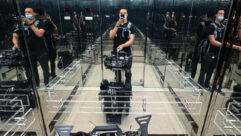
Behringer X32 Digital Mixer Review
Jan 16, 2013 12:27 PM,
Reviewer: John McJunkin
The company turns a corner with this professional and sturdy unit.

Behringer X32
Behringer has stepped up its design and execution game to enter the world of serious professional products with the introduction of the X32 digital mixer. Although a colleague told me that I would be shocked at the feature set, including its “Midas mic preamps,” my preconceived perceptions of Behringer mixers still overcame my ability to be intrigued.
However, my resistance began to thaw when more colleagues told me of their experiences with the mixer. When one colleague in particular, a Grammy Award-winning engineer, was compelled to replace a competitor’s digital mixer with the X32, I decided I needed to get a look at it. I did my best to clear my mind of my bias and had one sent for evaluation. It is now clear to me that Behringer not only designed an excellent product, but the company also carefully built it with quality components. I’d characterize this product as the first example of Behringer turning the corner and entering the field of serious pro audio.
The mixer has 32 XLR mic inputs, each with a Midas preamplifier. This is a pretty big deal—Midas makes excellent stuff. I admit that I am influenced by this brand name; it’s been a staple in quality live sound for a long time. But to prove it to myself, I listened, and they do sound good. One minor issue: The mixer doesn’t have balanced 1/4in. TRS inputs per channel, necessitating the use of DI boxes for musical instruments. Normally a line-level input bypasses the mic pre, which is not possible here, but considering the clean quality of the preamp, it’s not a major problem as long as the engineer manages the gain sequence properly.
The mixer also features 16 XLR outputs, six balanced 1/4in. line-level inputs and outputs, a stereo pair of RCA line-level inputs and outputs, XLR and TRS control room outputs, and a pair of stereo headphone jacks. One minor gripe: The headphone jacks are tucked into the corners of the recessed carry handle slots on either end of the mixer. If a 1/8in. to 1/4in. adapter is necessary, it may remain in the jack when the cable is unplugged, tucked into a corner where it is nearly impossible to grasp with thumb and forefinger. I had to use a pair of needle-nose pliers to extract an adapter more than once. Two AES50 ports on the console facilitate 48 channels of bi-directional communication with a stage box over a single Cat-5 cable. Two cables give the mixer access to as many as six Behringer S16 stage boxes for a total of 96 channels. Sixteen discrete monitor mixes are also available via Behringer’s proprietary Ultranet protocol. Any 32 inputs, analog or digital, can be assigned to the mixer’s channels, and internal digital resolution is 40-bit—yielding a huge amount of headroom. It runs fast, too, with overall latency at less than 1 millisecond, and less than 2 milliseconds round trip from stagebox to mixer back to stagebox.
There are 16 mix buses, six matrices, eight DCA groups, and the main LCR bus. The center channel can also be operated as a separate mono bus. The rear panel also features an AES/EBU output, Ethernet, and USB connections for remote control, MIDI I/O, and a card slot that can accommodate various I/O options. The mixer I evaluated had an XUF card with USB and FireWire connections, facilitating 32 channels going to and 32 channels coming back from a computer—perfect for DAW recording and playback. Having all this I/O right at the console makes me happy; other digital mixer manufacturers presume a digital snake from the stage, and offer very little analog I/O at the console itself; I’m pleased Behringer facilitates analog or digital input from stage or FOH location.
The control surface of the mixer departs radically from the look and feel of every Behringer mixer you’ve ever seen. It has a slick, artsy design, complete with a new logo in raised chrome-colored letters on the rear, like the branding badge on a car. Faders, mute, solo, and select buttons, along with LED meters and LCD scribble strips fill the lower two thirds of the control surface. In that same space, bank-switching buttons, mute group buttons, scene recall, and a section of assignable soft knobs, buttons, and scribble strips are found. The left half of the upper third of the control surface features LED-ringed knobs and backlit buttons controlling the mixer’s input gain, phantom power, and phase, along with gate and compression, four-band equalization, auxiliary sends, and buss assignment controls. There’s also a USB slot into which a thumb drive can be inserted, and a board mix can be recorded onto it or played back from it. At the lower right-hand corner of the control surface is a sign of the times: a smart phone cradle. There is also an iPad app enabling complete control of the mixer via Wi-Fi. I love to be able to walk around and tweak EQs and things.
To the right of these per-channel controls, the mixer’s 800×480 high contrast color TFT display provides the mixer’s status. It tilts up from the main surface for visibility, and below it are six soft knobs, each also a pushbutton. There are navigation controls to the right of these knobs, and above them are eight pushbuttons that determine which of the mixer’s displays is currently shown on the screen, including home, meters, routing, setup, library, effects, mute group, and utility. LED level meters represent L-R output and mic solo input levels between the TFT display and the eight selector buttons. Among the features controlled here are the mixer’s virtual signal processors, including great emulations of Lexicon, EMT, and Quantec reverbs, along with delays, chorusing, dynamics, graphic EQ (controllable on faders), and other such effects. Also, the mixer’s scene library is accessed here, facilitating recall of snapshots.
To the right of the TFT display section are the monitor and talkback controls, along with a talkback mic input, augmenting the mic built in to the base of the TFT display section. In addition to the main display, the scribble strips found above each fader and with each of the four soft knobs in the assignable control section feature 128×64 LCD displays with RGB color backlights with numerous colors, a must-have feature that quickly identifies whether a fader is assigned to control a regular mix channel, a DCA, an auxiliary, or a bus. These vivid little displays are clear and readable—very impressive. The 100mm motorized faders look and feel solid, commensurate with the sturdy feel of the rest of the controls and appearance of the displays.
It’s quite obvious that Behringer took the design seriously, and evidently made build just as important of a quality as design. This mixer represents a completely new level for Behringer and a huge step up from the “cheap gear” classification given to the company by pros and critics alike. And it sounds great too. The four-band parametric EQs sound very good, and the dynamics processing is particularly sweet in my opinion. I like to aggressively compress some things, and these compressors enable me to do so, or they can be toned down to be transparent. The effects sound great as well, and noise and distortion are both very low throughout the signal chain. The Midas mic pres are excellent and lend a really professional level of quality that sounds a lot more expensive. This mixer blows me away. In evaluating it on its merits while putting brand name and price out of my mind, I truly believe that Behringer has turned a corner here. Watch the company in the months and years to come. It’s a company that’s starting to raise the bar. The only question remaining in my mind is whether the build quality is such that this mixer will withstand life on the road and deliver years of service without failure. I will be keeping an eye on this over time. I plan on engaging in whatever scheming is necessary to keep this evaluation unit. Seriously, I don’t want to send it back.
PRODUCT SUMMARY
Pros: A powerful and well-appointed live mixer, exceptional value for the price
Cons: Poorly located headphone jacks for certain types of adapters
Applications: Live sound scenarios, some limited recording functionality
Price: $2,999.99
SPECIFICATIONS
Frequency range (FS = 48kHz, 0dB to -1dB): 10Hz – 22kHz
THD + Noise, 20 dB Gain, 0 dBu Out: 0.008% (0.006% A-weighted)
Dynamic range (typical): 104dB
Cross Talk Rejection @ 1 kHz: 100dB
Nominal Input Level: +21dBu
Input Impedance XLR, Unbal./Bal.: 5kΩ/10kΩ
Input Impedance TRS Jack, Unbal./Bal.: 20kΩ/40kΩ
Non Clip Maximum Input Level, XLR: +23dBu
Non Clip Maximum Input Level, TRS: +16dBu
Output Level, XLR, Nom./max.: +4dBu/+21dBu
Output level, TRS, nom./max.: +4dBu/+16dBu
Output Impedance, XLR, Unbal./Bal.: 75Ω/75Ω
Output Impedance, TRS, Unbal./Bal.: 150Ω/300Ω
Residual Noise Level, XLR and TRS: -83dBu (-85dBu A-weighted)
Equivalent Input Noise Level, XLR (Input Shorted): -128dBu
CMRR, XLR, @ 20 dB Gain (typical): 70dB
CMRR, XLR, @ 40 dB Gain: 80dB
Dimensions: 35.4”x20.8”x7.9”
Weight: 45.4lbs.
John McJunkin is the principal of Avalon Podcasting in Chandler, Ariz., and produces and co-hosts a top-rated morning radio talk show in Phoenix. He has consulted in the development of studios and installations and provides high-quality podcast and voice production services.










